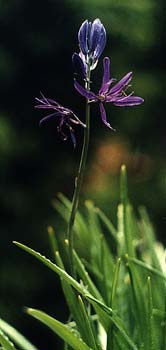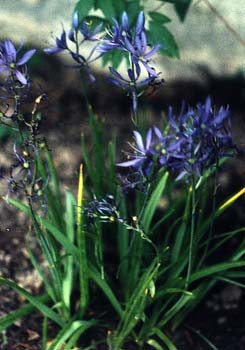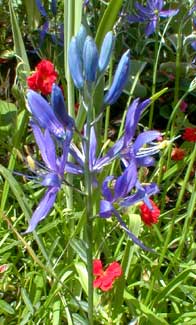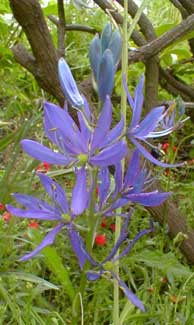
Camas Flower;
or, Indian Hyacinth
"Yesterday, I ate camas — a little white onion-like, crocus-like bulb — at the Mima Mounds. It was slightly sweet, starchy, dissolving to a gelatinous-pudding-like substance. The Indians cropped it in the Mima Mounds."
-Jan Haag
b. 1933
b. 1933
 The one to two-inch bulbs of Camassia quamash are edible & were a Native American delicacy among the Blackfoots, Cree, Nez Pierce & other of the First Peoples.
The one to two-inch bulbs of Camassia quamash are edible & were a Native American delicacy among the Blackfoots, Cree, Nez Pierce & other of the First Peoples.If steamed or pit-cooked very slowly for at least a full day (up to whopping three days), the bulbs' bland complex sugar (called inulin) breaks down into sweet fructose. Fully one-third of its cooked weight becomes easily digestable fructose.
The reason blue camas is sometimes called "black camas" is because when slowly pit-cooked, the bulb turns black. After being cooked to maximum sweetness & black coloration, the first peoples would dry it out & grind it to mix with flower, water, & butter, to make gravy.
Here in the Northwest long before the arrival of white imigrants, aboriginal women practiced a semi-domesticating agriculture to maximize camas harvests.
 They cared for the damp grassy open habitat by weeding out the similar-looking but toxic "Death Camas" (Zigadenus spp) & would burn off the grass & all invading weeds after harvests, so that larger plants & shrubs would not establish themselves, thus preserving the meadowy location as ideal for wild camas.
They cared for the damp grassy open habitat by weeding out the similar-looking but toxic "Death Camas" (Zigadenus spp) & would burn off the grass & all invading weeds after harvests, so that larger plants & shrubs would not establish themselves, thus preserving the meadowy location as ideal for wild camas.Because the bulb takes several years to mature, natural populations have vanished in much of its range. It's not apt ever in the modern age to become a food crop. I am very curious about how they would taste, but I am not apt to eat any of my own, as I too much like them alive, plus their preparation is an ordeal.
Its genus name Camassia & its species name quamash is a redundancy, adapting the Indian name Quamash for genus & species alike. Whites also called it Indian Hyacinth, though most people to this day call it Camas.
It was first described in 1827 by David Douglas, & a few species of Camas had made it to the east coast thence to England for gardeners's delight by the 1850s.
 The turf-like leaves begin to show themsevles in our garden in March. These slowly reach about 18 inches tall, with flower stems higher, adorned with beautiful blue buds that open into six slender loose petals in May & June.
The turf-like leaves begin to show themsevles in our garden in March. These slowly reach about 18 inches tall, with flower stems higher, adorned with beautiful blue buds that open into six slender loose petals in May & June.It is adaptable as to condition, growing wild in meadows, moist lowlands, along the edges of grassy prairies, & on bluffs or rocky outcroppings. Camas prefers moist acidic soil, with good drainage more than averagely essential.
In the garden, well-turned soil with lots of compost in full sun satisfies them best. It is not especially tolerant of deep shade, though it does sometimes grow naturally in Douglas fir forests rather than its preferred wet meadow, so will adapt to partial shade. Given a sunny situation, Camas will naturalize in the garden, behaving rather like Grape Hyacinth, which may even strike some gardeners as invasive.
Bulbs do not produce many offsets, but camas spreads readily by seed. The seeds take two years to mature & bloom. It has many color variations even in the wild, plus garden cultivars, so that it ranges from white to deepest blue. The patch of camas growing in front of the native Rosy Spirea & shown in the first two pictures on this page is silvery-blue, grown from wild-gathered seeds from British Columbia (it's shown in the first photo).
The third photo shows a paler blue camas, together with little red pompoms of 'Fireball' Sunrose. This one is in a patch of camas grown from corms produced in Holland. This bigger patch is at the dripline of a 'Jeanne Marie' Rhododendron. A third smaller patch under a 'White Icicle' Flowering Current is a clone called 'Blue Melody' purchased already growing, & that one has variegated grassy leaves.
I just love this little species of camas. It's heart-stoppingly beautiful in its elegance & simplicity.
See also the garden clone
Camasia quamash 'Blue Melody'
Camasia quamash 'Blue Melody'